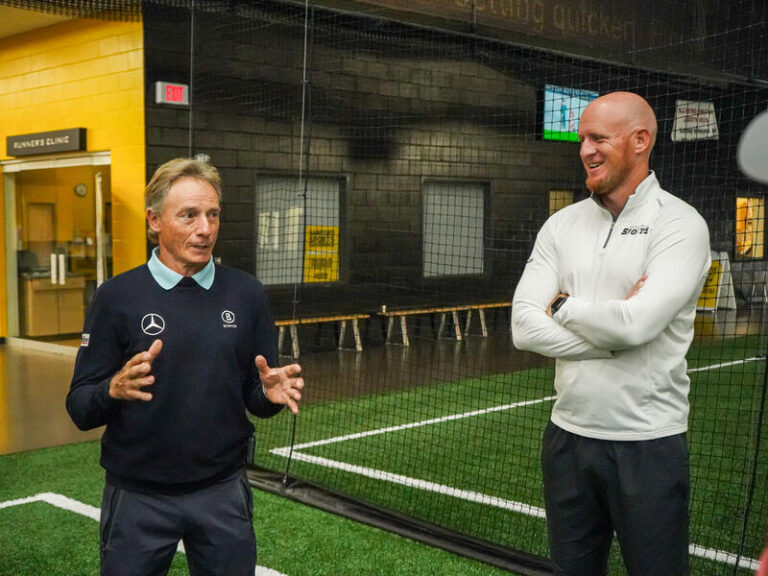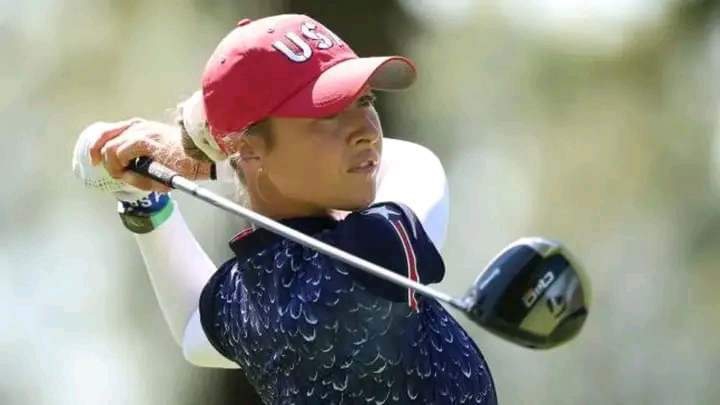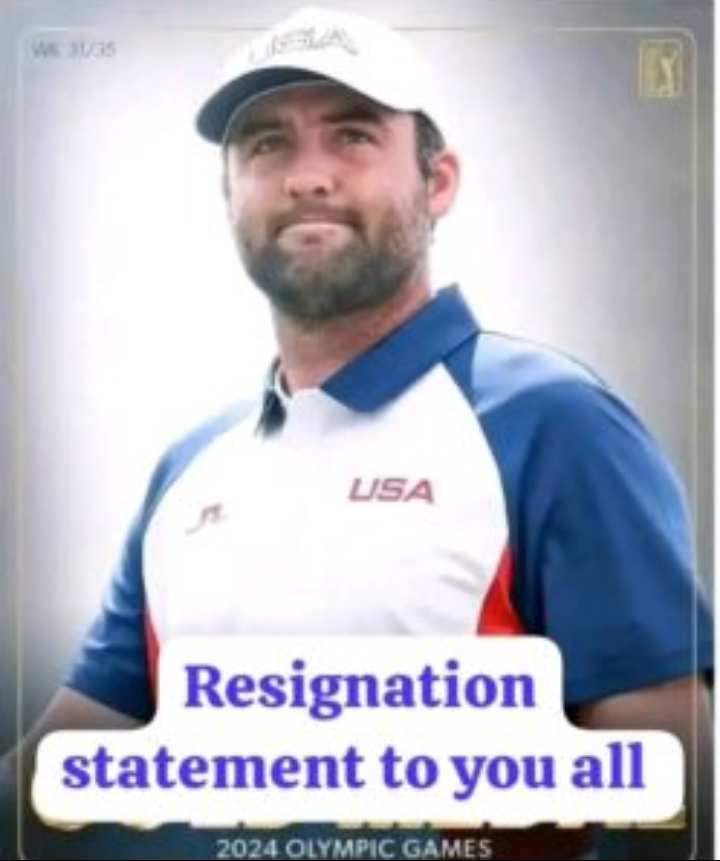Golf legend returns after nearly career-ending Achilles tear
Bernhard Langer is 67 years old and is a decade past the age when many of his contemporaries in professional golf begin to fade off the PGA Tour Champions leader boards. This week he visited the Sanford Fieldhouse and had a conversation with Sanford Sports staff. Langer, who has been a Sanford Health…
Bernhard Langer is 67 years old and is a decade past the age when many of his contemporaries in professional golf begin to fade off the PGA Tour Champions leader boards.
This week he visited the Sanford Fieldhouse and had a conversation with Sanford Sports staff. Langer, who has been a Sanford Health ambassador to the world of professional golf and a member of the Sanford International board, makes annual visits to the Sioux Falls, South Dakota facility the week of the tournament.
Normally his conversation, which this year included certified athletic trainer Kyle Johnson, golf coach Sam Vosler and physical therapist Adam Moen, would have included a lot about how he has been able to sustain his status as one of the PGA Tour Champions’ top players. He would explain in some detail the kinds of things he is doing to prepare to play in Sanford International this week at Minnehaha Country Club.
- This year is not like the others, however. In February, Langer tore his Achilles tendon playing pickleball in Florida — participating in sports besides golf has always been part of his training regimen — and for an undetermined amount of time he was going to be inactive.
COMING BACK QUICKLY.
that many years ago, this would have been regarded as a potentially career-ending injury for a pro golfer half his age. Instead, three months after surgery to repair his Achilles, he was back to playing in tournaments.
Given that he has established a legendary capacity to overcome the inconveniences that come with getting older, it was not surprising how he was able to return so quickly. Nevertheless, a torn Achilles is a significant injury for anyone.
“I could have retired,” Langer said. “I could have said ‘OK, well, this is it.’ I’m 66, let’s just pack it in. I have nothing to prove. I don’t need it financially. Let’s just enjoy the grandkids and stay at home. But that’s not me. I’m a very competitive person and I still enjoy being out there. I knew I could perform if I’m somewhat healthy.”
He was right about that. Langer has finished in the top eight in his last four tournaments. This includes last week nearly winning the Ascension Charity Classic in St. Louis, taking Y.E. Yang to a sudden-death playoff.
September in South Dakota is a long way from February in Florida. The morning he went down he was backing up to reach a lob shot during an extended pickleball session, then jumped and delivered an overhead slam. He landed, heard a loud noise and rolled to the ground. He thought, in his words, he’d “been hit with a hammer.”
A doctor friend playing on a nearby court came to his aid and quickly hinted he had torn his Achilles. The doctor’s intervention saved Langer a trip to the emergency room. Instead, he had an MRI shortly thereafter and was in a boot in the afternoon. A day later he was in surgery. On the following Monday he was already in rehab.
LEARNING AND HEALING
Most people really don’t know what it takes to come back from an Achilles tear until it happens to them. For Langer, it was an educational process in addition to a healing process.
“It was uncharted territory for me to figure out the best way to go,” Langer said. “Communication is key. I was in constant communication with my surgeon, with my physical therapy and with my two doctor friends. I had to pick their brains, find out what they would recommend, and what it should feel like or what the next step is. There is always a next step in the process of recovering for this.”
Langer followed his providers’ instructions, though he admitted to talking them into accepting he was going to push the pace on conventional time frames that go with Achilles tear recovery.
After two-and-a-half months he was chipping and putting, but before getting serious about swinging at full speed, he had a visit with his golf coach. Together they discovered that he could hit a golf ball the same way he did before the injury.
That represented the green light Langer was impatiently waiting to see.
“That was great news because that meant I could be back playing professional golf fairly soon, as long as I don’t have to change my swing,” he said. “And then it was somewhat clear to me, if I can move the way I want to move, I should be able to be as competitive as I was before the injury in a fairly short time.
Walking remains uncomfortable and Langer rides in a cart for now during his rounds. Getting back to being on his feet six hours a day is one of those next steps. Though he’s not completely healed yet, his recovery to this point stands out as an example of how to do it right when you’re in your 60s.
“The benefit Bernhard has is that he is really in tune to his body,” Moen said. “He’s super fit. He has that team around him where he stays in shape, and he plays a sport where he has to be on his feet all the time. That’s a huge difference for him versus someone who goes out and plays pickleball on weekends and has a desk job during the week.
STAYING POSITIVE.
Langer’s time since the injury included a 45-minute phone call with Aaron Rodgers, the New York Jets quarterback who sat out all but a few minutes of the last football season with an Achilles tear. Though the physical demands of the two sports are dramatically different, they’re both athletes competing against people who are much younger than they are. They are both cheating Father Time.
“I wanted to pick his brain and see what he’s doing in rehab,” Langer said. “I wanted to know how he went about it and what his goals are and his day-to-day routine. It was a great conversation.
During the conversation with the Sanford Sports staff, a question was asked about how Langer got through it. How did he navigate dealing with an injury that was going to take time and effort to come back from?
The golfing legend’s answer would apply to many of the challenges we all face.
“I just try to be lighthearted and positive about it,” Langer said. “It’s meant to be and that’s fine. I’m going to be out for a few months, but I’ll get back and I’ll make the best of it. Let’s enjoy this time instead of saying, ‘Oh, poor me. Why is this happening to me?’ That doesn’t help. I was very positive with all that, and then my faith in God has helped me a great deal too, to keep it all in perspective.”
Hearteningly for those weekend warriors who are trying to come back from Achilles surgery, the same kind of expertise that helped Langer get back to golf is available from the staff at Sanford Sports.
“I was really impressed with his positivity and how that got him through it,” Moen said. “He was so regimented in how he approached it and set goals. Setting goals is super important. Whether I’m dealing with a professional athlete or I’m dealing with someone who just wants to get back to walking around the block, you have to have a goal. That mindset is a huge part of anybody’s recovery.”


